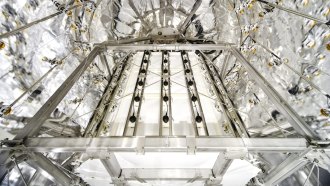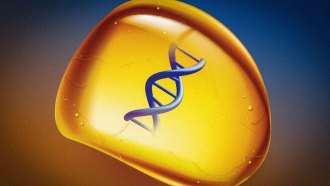Physics
-
 Quantum Physics
Quantum PhysicsA quantum computer corrected its own errors, improving its calculations
The corrected calculation had an error rate about a tenth of one done without quantum error correction.
-
 Health & Medicine
Health & Medicine50 years ago, some of plastic’s toxic hazards were exposed
Worker exposure to vinyl chloride became tightly regulated after the chemical was linked with liver cancer. Now, its use may be on the chopping block.
-
 Physics
PhysicsA nuclear clock prototype hints at ultraprecise timekeeping
Nuclear clocks could rival atomic clocks and allow for new tests of fundamental physics. A new experiment demonstrates all the ingredients needed.
-
 Physics
PhysicsMayo is weirdly great for understanding nuclear fusion experiments
Mayonnaise’s texture is perfect for mimicking what a fusion fuel capsule goes through after it’s blasted with lasers.
-
 Particle Physics
Particle PhysicsThe possibilities for dark matter have just shrunk — by a lot
The LZ dark matter experiment has ruled out weakly interacting massive particles, or WIMPs, with a wide range of properties.
-
 Physics
PhysicsThe world’s fastest microscope makes its debut
Using a laser and an electron beam, the microscope can snap images of moving electrons every 625 quintillionths of a second.
By Skyler Ware -
 Climate
ClimateZigzag walls could help buildings beat the heat
A corrugated exterior wall reflects heat to space and absorbs less heat from the ground, keeping it several degrees cooler than a flat wall.
-
 Physics
PhysicsPaper cut physics pinpoints the most hazardous types of paper
Dot matrix printer paper is the most treacherous, physicists report. Magazine paper comes in second.
-
 Particle Physics
Particle PhysicsDark matter experiments get a first peek at the ‘neutrino fog’
The hint of fog marks a new way to observe neutrinos, but points to the beginning of the end for this type of dark matter detection.
-
 Chemistry
ChemistryA new element on the periodic table might be within reach
Scientists made the known element 116 with a beam of titanium atoms, a technique that could be used to make the undiscovered element 120.
-
 Physics
PhysicsCan light spark superconductivity? A new study reignites debate
Brief blasts of light might make some materials into fleeting superconductors. Magnetic measurements strengthen the case for this controversial claim.
-
 Materials Science
Materials ScienceJurassic Park’s amber-preserved dino DNA is now inspiring a way to store data
DNA is capable of encoding all sorts of data. Storing it in an amberlike material may keep that information safe for nearly forever.
By Payal Dhar